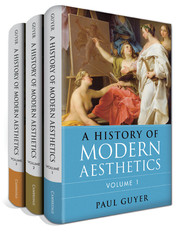Book contents
- Volume 1 The Eighteenth Century
- Volume 2 The Nineteenth Century
- Volume 3 The Twentieth Century
- Frontmatter
- Contents
- Acknowledgments
- Introduction
- Part One German Aesthetics in the Twentieth Century
- Part Two Aesthetics in Britain until World War II
- Part Three American Aesthetics in the First Half of the Twentieth Century
- Part Four Wittgenstein and After
- Bibliography
Part Four - Wittgenstein and After
Anglo-American Aesthetics in the Second Part of the Twentieth Century
from Volume 3 - The Twentieth Century
Published online by Cambridge University Press: 05 June 2015
- Volume 1 The Eighteenth Century
- Volume 2 The Nineteenth Century
- Volume 3 The Twentieth Century
- Frontmatter
- Contents
- Acknowledgments
- Introduction
- Part One German Aesthetics in the Twentieth Century
- Part Two Aesthetics in Britain until World War II
- Part Three American Aesthetics in the First Half of the Twentieth Century
- Part Four Wittgenstein and After
- Bibliography
Summary
The publication of Ludwig Wittgenstein’s Philosophical Investigations in 1953, two years after his death, was an epochal event in the history of philosophy, first in Britain and America but ultimately in other areas such as Germany as well. Wittgenstein turned much philosophy away from the study of highly formalized discourses such as those of mathematics and physics, an orientation that was to some extent due to Wittgenstein’s own earlier Tractatus Logico-Philosophicus, first published in 1919, toward the analysis of the conditions for the meaningful use of language in a much broader range of human discourses and activities; ultimately the new approach, captured by the slogan “meaning is use,” expressing the emphasis on the manifold ways language is used rather than on a single metaphysical model of the relation between word and object, was brought back to the case of mathematics itself, as in Wittgenstein’s Remarks on the Foundations of Mathematics, also published posthumously in 1956. Of course, Wittgenstein was not alone in inaugurating what was somewhat misleadingly called “ordinary language” philosophy – misleadingly, because at least in Wittgenstein’s case, his method relied more on the invention of model “language games” to bring out general points than on the description of actual natural languages – and the Oxford philosophers Gilbert Ryle (1900–76) and John Langshaw Austin (1911–60) also made indispensable contributions to the new movement. Some of the aestheticians to be discussed in this part, such as Frank Sibley and Stanley Cavell, certainly took some of their inspiration from these two philosophers, respectively, as well as from Wittgenstein himself. But not only was Wittgenstein the only one of the three leaders of ordinary-language philosophy who explicitly discussed aesthetics at even moderate length, in the work published in 1967 as Lectures and Conversations on Aesthetics, Psychology, and Religious Belief (a work based on classes Wittgenstein had given back in 1938, as previously mentioned); it was Wittgenstein whose more general philosophy had the most profound impact on the development of aesthetics in both Britain and the United States beginning in the 1950s. So this part will begin with a chapter on Wittgenstein, focusing on those aspects of his philosophy that turned out to be most significant for the subsequent history of aesthetics.
- Type
- Chapter
- Information
- A History of Modern Aesthetics , pp. 429 - 431Publisher: Cambridge University PressPrint publication year: 2014



